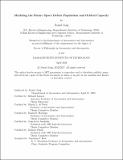Modeling the Future Space Debris Population and Orbital Capacity
Author(s)
Jang, Daniel
DownloadThesis PDF (26.05Mb)
Additional downloads
Advisor
Linares, Richard
Terms of use
Metadata
Show full item recordAbstract
Increased investments and technological advances in satellite manufacturing and launch services have led to a newly vitalized Low Earth Orbit (LEO) environment. Megaconstellations consisting of hundreds to hundreds of thousands of satellites have been proposed, with SpaceX’s Starlink satellite constellation now reaching more than 5400 operational satellites. This denser LEO environment underscores the urgent need for models to predict and manage the risk of collisions and the sustainable use of space. Many models have been proposed over the years to quantify the risk of collisions between resident space objects, including the seminal paper by Kessler that described the runaway conditions for which LEO could become unusable. In this thesis, the development of the MIT Orbital Capacity Analysis Tool (MOCAT) is described along with conclusions and insights. MOCAT is a novel open-source approach to evaluating the LEO environment and comprises of a Source Sink Evolutionary Model (SSEM) and a Monte Carlo (MC) method. The SSEM simplifies the complex dynamics of space-object interactions into deterministic equations, focusing on the long-term evolution of orbital populations across different altitude shells. The simplified nature of the SSEM allows for computational efficiency, which enables optimization routines such as the exploration of equilibrium solutions for LEO carrying capacity. The improvements to the SSEM in this work through binning in the physical dimension as well as inclusion of Delta-V dynamics from the collision dynamics increases the fidelity of the SSEM. In comparison, MOCAT-MC offers a comprehensive means to simulate the individual interactions between RSOs. The MOCAT-MC tool propagates the orbits of low-earth orbit objects and models their interactions including collisions and explosions, and provides insights into the evolving trends of the LEO population. Of particular note is the computational efficiency of the model, which is essential for managing the complexities inherent in orbital dynamics and the potential large number of objects centuries into the future. Validation results and a range of simulations, including no-future launch scenarios and the launch of proposed megaconstellations totaling more than 80,000 active payloads are explored, resulting in millions of trackable objects. Despite the much fewer megaconstellations planned at the higher altitudes, even a small fraction of failures in post-mission disposal or collision avoidance maneuvers result in an outsized effect on orbital debris accumulation. MOCAT-MC is able to simulate Lethal Non-Trackable (LNT) objects, which comprise the vast majority of the orbital population today. These lethal non-trackable object population will only grow as more payloads and debris are launched into orbit and increase the collision rate. The effect of these objects are modeled and discussed. These two models offer different approaches to modeling the future orbital environment each with its strengths and weaknesses. Validation against existing models in literature shows the utility of MOCAT in informing future space traffic management and constellation design. The MOCAT tool has been created such that researchers can use a common model that is validated, robust, and efficient, allowing for advancement in our ability to forecast and mitigate the risks associated with the increasing density of LEO while advocating for a more sustainable approach to space exploration and utilization.
Date issued
2024-05Department
Massachusetts Institute of Technology. Department of Aeronautics and AstronauticsPublisher
Massachusetts Institute of Technology